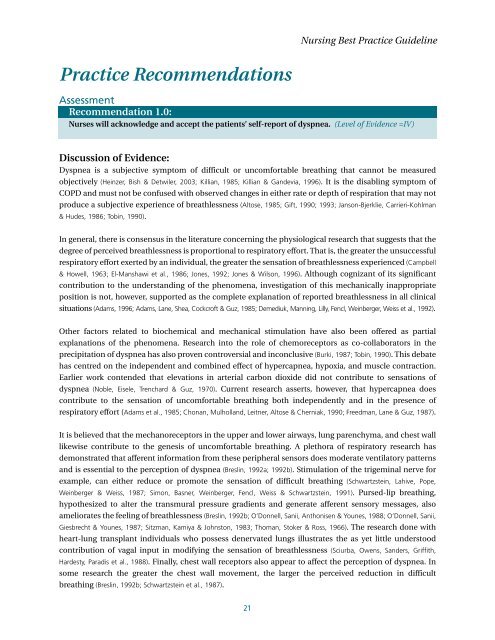Nursing Care of Dyspnea: The 6th Vital Sign in Individuals with ...
Nursing Care of Dyspnea: The 6th Vital Sign in Individuals with ...
Nursing Care of Dyspnea: The 6th Vital Sign in Individuals with ...
Create successful ePaper yourself
Turn your PDF publications into a flip-book with our unique Google optimized e-Paper software.
<strong>Nurs<strong>in</strong>g</strong> Best Practice Guidel<strong>in</strong>ePractice RecommendationsAssessmentRecommendation 1.0:Nurses will acknowledge and accept the patients’ self-report <strong>of</strong> dyspnea. (Level <strong>of</strong> Evidence =IV)Discussion <strong>of</strong> Evidence:<strong>Dyspnea</strong> is a subjective symptom <strong>of</strong> difficult or uncomfortable breath<strong>in</strong>g that cannot be measuredobjectively (He<strong>in</strong>zer, Bish & Detwiler, 2003; Killian, 1985; Killian & Gandevia, 1996). It is the disabl<strong>in</strong>g symptom <strong>of</strong>COPD and must not be confused <strong>with</strong> observed changes <strong>in</strong> either rate or depth <strong>of</strong> respiration that may notproduce a subjective experience <strong>of</strong> breathlessness (Altose, 1985; Gift, 1990; 1993; Janson-Bjerklie, Carrieri-Kohlman& Hudes, 1986; Tob<strong>in</strong>, 1990).In general, there is consensus <strong>in</strong> the literature concern<strong>in</strong>g the physiological research that suggests that thedegree <strong>of</strong> perceived breathlessness is proportional to respiratory effort. That is, the greater the unsuccessfulrespiratory effort exerted by an <strong>in</strong>dividual, the greater the sensation <strong>of</strong> breathlessness experienced (Campbell& Howell, 1963; El-Manshawi et al., 1986; Jones, 1992; Jones & Wilson, 1996). Although cognizant <strong>of</strong> its significantcontribution to the understand<strong>in</strong>g <strong>of</strong> the phenomena, <strong>in</strong>vestigation <strong>of</strong> this mechanically <strong>in</strong>appropriateposition is not, however, supported as the complete explanation <strong>of</strong> reported breathlessness <strong>in</strong> all cl<strong>in</strong>icalsituations (Adams, 1996; Adams, Lane, Shea, Cockcr<strong>of</strong>t & Guz, 1985; Demediuk, Mann<strong>in</strong>g, Lilly, Fencl, We<strong>in</strong>berger, Weiss et al., 1992).Other factors related to biochemical and mechanical stimulation have also been <strong>of</strong>fered as partialexplanations <strong>of</strong> the phenomena. Research <strong>in</strong>to the role <strong>of</strong> chemoreceptors as co-collaborators <strong>in</strong> theprecipitation <strong>of</strong> dyspnea has also proven controversial and <strong>in</strong>conclusive (Burki, 1987; Tob<strong>in</strong>, 1990). This debatehas centred on the <strong>in</strong>dependent and comb<strong>in</strong>ed effect <strong>of</strong> hypercapnea, hypoxia, and muscle contraction.Earlier work contended that elevations <strong>in</strong> arterial carbon dioxide did not contribute to sensations <strong>of</strong>dyspnea (Noble, Eisele, Trenchard & Guz, 1970). Current research asserts, however, that hypercapnea doescontribute to the sensation <strong>of</strong> uncomfortable breath<strong>in</strong>g both <strong>in</strong>dependently and <strong>in</strong> the presence <strong>of</strong>respiratory effort (Adams et al., 1985; Chonan, Mulholland, Leitner, Altose & Cherniak, 1990; Freedman, Lane & Guz, 1987).It is believed that the mechanoreceptors <strong>in</strong> the upper and lower airways, lung parenchyma, and chest walllikewise contribute to the genesis <strong>of</strong> uncomfortable breath<strong>in</strong>g. A plethora <strong>of</strong> respiratory research hasdemonstrated that afferent <strong>in</strong>formation from these peripheral sensors does moderate ventilatory patternsand is essential to the perception <strong>of</strong> dyspnea (Bresl<strong>in</strong>, 1992a; 1992b). Stimulation <strong>of</strong> the trigem<strong>in</strong>al nerve forexample, can either reduce or promote the sensation <strong>of</strong> difficult breath<strong>in</strong>g (Schwartzste<strong>in</strong>, Lahive, Pope,We<strong>in</strong>berger & Weiss, 1987; Simon, Basner, We<strong>in</strong>berger, Fencl, Weiss & Schwartzste<strong>in</strong>, 1991). Pursed-lip breath<strong>in</strong>g,hypothesized to alter the transmural pressure gradients and generate afferent sensory messages, alsoameliorates the feel<strong>in</strong>g <strong>of</strong> breathlessness (Bresl<strong>in</strong>, 1992b; O’Donnell, Sanii, Anthonisen & Younes, 1988; O’Donnell, Sanii,Giesbrecht & Younes, 1987; Sitzman, Kamiya & Johnston, 1983; Thoman, Stoker & Ross, 1966). <strong>The</strong> research done <strong>with</strong>heart-lung transplant <strong>in</strong>dividuals who possess denervated lungs illustrates the as yet little understoodcontribution <strong>of</strong> vagal <strong>in</strong>put <strong>in</strong> modify<strong>in</strong>g the sensation <strong>of</strong> breathlessness (Sciurba, Owens, Sanders, Griffith,Hardesty, Paradis et al., 1988). F<strong>in</strong>ally, chest wall receptors also appear to affect the perception <strong>of</strong> dyspnea. Insome research the greater the chest wall movement, the larger the perceived reduction <strong>in</strong> difficultbreath<strong>in</strong>g (Bresl<strong>in</strong>, 1992b; Schwartzste<strong>in</strong> et al., 1987).21
















